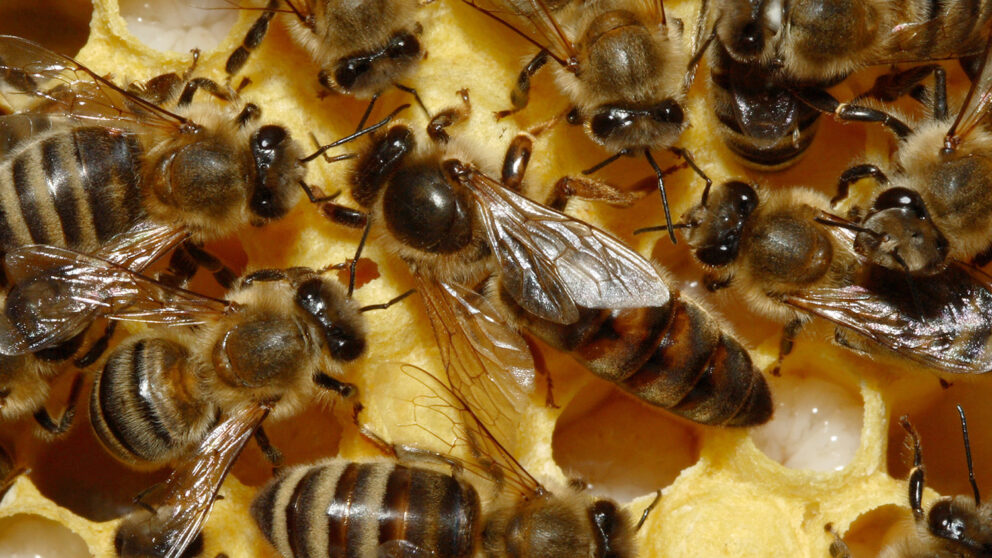Beekeepers could soon have a new option for protecting hives from a devastating disease: the first vaccine for insects.
Earlier this month, the U.S. Department of Agriculture gave conditional approval to a new product from Georgia biotech company Dalan Animal Health that targets a bacterial disease called American foulbrood.
It’s not a vaccine in the traditional sense — immunity is conferred by treating the queen, meaning no bees will be waiting in line for shots, says David Tarpy, a professor and Extension specialist in apiculture with North Carolina State University.
We asked Tarpy to explain the science behind this new option and what it could mean for beekeepers.
What is significant about the USDA approval?
I believe this is the first registered product of its kind for insects since so few are “domesticated” insects under the USDA veterinary umbrella. It is based on a research paradigm, demonstrated first on beetles, then on other insects until finally being shown in honey bees, that suggests transgenerational immune priming or TGIP.
This is where a mother exposed to a pathogen somehow transmits immunity through the eggs so that her offspring are less susceptible to the same strain of the same disease. This is not a genetic manipulation or permanent change, although the exact mechanism of this maternal effect is unknown. The research funded and published by this company suggests a modest (30-50%) reduction in the infection of inoculated larvae in a controlled laboratory setting. It is unclear at this point, however, how well this will translate to a real-world environment, but our understanding is that field trials are currently underway.
How do you vaccinate honey bees?
Beekeepers mix the product – in essence, dead cells of the bacterium that causes the disease – into “queen candy,” pretty much cake fondant that beekeepers can feed to colonies since a major part of their diet is sugar. The workers then feed the queen, which in turn primes the eggs she lays to have this transgenerational immune priming.
What causes American foulbrood? What happens to infected hives? Where did the disease get its name?
It’s caused by a spore-forming bacterium, Paenibacillus larvae. It is widely known as the most noxious brood pathogen of honey bee colonies because it is so contagious and devastating. It got its moniker from the main symptom since dead larvae decompose and produce a very potent smell – like dirty gym socks put in a Ziploc bag stored in your truck during a hot summer day.
Could this approach be used for other threats to honey bees?
That is the hope. The company with this current product has another honey bee bacterial pathogen (European foulbrood) and fungal pathogen (Chalkbrood) in its pipeline. I am particularly hopeful that this approach might be used for the many viral pathogens that honey bees face, but because they are so much different than bacterial pathogens – and the insect immune system responds to them differently – much more research needs to be done before this might be a useful application.

How could commercial beekeepers benefit from the vaccine?
Beekeepers would benefit in several ways. First, they would be less reliant on antibiotics to mitigate disease, which would further reduce antibiotic-resistant strains and contamination of honey. Second, since antibiotics only prevent the bacteria from sporulating – it doesn’t kill the spores, just prevents them from infecting – the only true way to eradicate the disease is to kill the bees and burn this hive equipment, resulting in tremendous economic losses for the beekeeper.
What essential role do honey bees fill in pollinating plants? How many of our food and fiber crops require honey bees or other pollinators?
Honey bees are the primary insect pollinator of about 100 different crops grown in the U.S., accounting for increased yield and billions of dollars in added economic productivity. Without honey bees and other pollinators, we wouldn’t have roughly one-third of what we eat every day, especially all of the fruits, vegetables and nuts that constitute a healthy diet.
How big a problem is American foulbrood in North Carolina?
Because the state Department of Agriculture & Consumer Services Apiary Inspection Service does such a great job in keeping the North Carolina honey bee population healthy, the number of colonies with detectable American foulbrood is less than 1%. This doesn’t make it rare, however, since outbreaks can be devastating to a beekeeper and easily transmittable within and among operations.
How do we monitor threats to honeybees, including diseases?
There are six full-time apiary inspectors across North Carolina, which is the envy of most other state departments of agriculture. They routinely go out to beekeeping operations to inspect them for signs of disease and other stressors in order to give sage advice on options for control.
What other threats are honeybees and other pollinators facing in our state?
In honey bees, we have three main issues:
- Parasites and pathogens, particularly the parasitic mite called Varroa destructor and the many viral pathogens that it spreads.
- Nutritional stress, mostly driven by habitat loss and a lack of forage for nectar and pollen.
- Pesticides, particularly insecticides designed to kill pest insects that have off-target effects on beneficial insects like honey bees.
When it comes to managed honey bees, the overall goal is to make beekeeping sustainable and reduce the high levels of colony mortality we see every year, averaging about 40%. For other pollinators, however, the goal is habitat and landscape conservation since most of them are solitary, wild-living native bees not actively managed by beekeepers.
This post was originally published in College of Agriculture and Life Sciences News.
